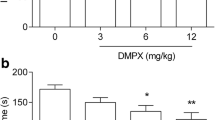Abstract
The tail suspension test is a behavioural primary screen for detecting potential antidepressant drugs. In this test, a reduction of duration of immobility after treatment with imipramine is obtained in mice of the NMRI strain but not of the CD1 strain. The present experiments evidence important differences between individuals of the latter strain in both the amount of immobility observed in naive mice and the effects of three antidepressants. The reproducibility of the tail suspension-induced behavioural despair was high in individual CD1 male mice and allowed a preselection of spontaneous high and low immobility scorers. Only the high immobility scorers were responsive to imipramine (30 mg/kg), desipramine (30 mg/kg) and paroxetine (10 mg/kg). The percentage of spontaneous high immobility scorers was higher in NMRI (50%) than in CD1 (20%) mice, justifying the use of the former strain for screening potential antidepressants. However, controlling for individual differences in the spontaneous performance in this animal model of depression may provide a useful tool to study behavioural, neurochemical and neuroendocrine correlates of antidepressant action.
Similar content being viewed by others
Author information
Authors and Affiliations
Additional information
Received: 24 February 1997 / Final version: 25 June 1997
Rights and permissions
About this article
Cite this article
Vaugeois, JM., Passera, G., Zuccaro, F. et al. Individual differences in response to imipramine in the mouse tail suspension test. Psychopharmacology 134, 387–391 (1997). https://doi.org/10.1007/s002130050475
Issue Date:
DOI: https://doi.org/10.1007/s002130050475




